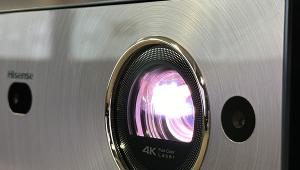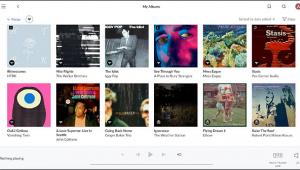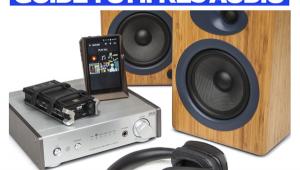I'm pretty old school. Extensive LP and CD library. I have a couple of CD's ripped from HD Tracks downloads and yes, they sound fantastic. My issue is storage. If I acquire a vast catalog of downloaded music in a high resolution format aren't I also needing a great deal of hard drive storage space? Granted it will take up less space than a CD or LP collection but aren't we still talking many many terabytes of data?
Guide To Hi-Res Audio - FAQ


FAQ: Understanding Hi-Res Audio and why you want it.
What is Hi-Res Audio?
Hi-Res Audio (HRA) offers the highest digital sound quality while retaining the benefits of digital audio, such as portability and personalization. HRA provides listeners greater sound clarity and detail than MP3s and other compressed digital audio formats.
Typically, hi-res downloads are a minimum of 96-kHz/24-bit, with 192-kHz/24-bit becoming increasingly popular.
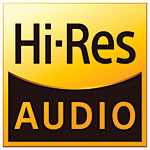 What audible benefits does Hi-Res Audio provide?
What audible benefits does Hi-Res Audio provide?
Hi-Res Audio tracks capture the details, instrument and vocal timbre and textures that listeners typically sacrifice when listening to MP3s, CDs or streamed Internet music and allows music to be heard as the artists originally intended.
Why should consumers care about Hi-Res Audio?
With the growing popularity of compressed digital downloads from online music stores and compressed live streams from popular Internet music services, consumers are sacrificing sound quality for convenience. Hi-Res Audio represents an opportunity for consumers to get closer to a studio experience and hear more emotionally engaging music.
Do I need to be a techie to get into Hi-Res Audio?
No, but here’s a quick primer to help you better understand the key features that make audio “high resolution.”
All music can be represented by a single, varying waveform that changes over time.
Digital audio measures the waveform’s voltage at regular intervals, converts these voltages to digital data through a device called an “analog-to-digital converter” and then stores the data in computer memory. This process is similar to how a video camera captures moving images by taking individual frames.
With audio, the rate at which you measure the waveform is called the “sample rate.” A CD-based system samples the waveform 44,100 times a second, while Hi-Res Audio typically measures a waveform 96,000 or even 192,000 times a second. This higher sample rate allows the faithful recording of much higher frequencies, resulting in a vastly larger audio bandwidth.
Playback reads the voltages at the same rate and same order in which they were stored. Because we can’t hear digital data, it’s necessary to pass this data through a digital-to-analog converter to reconstruct the original waveform. This analog signal can then drive speakers and headphones.
Another hi-res spec called “bit depth” indicates the resolution of each waveform measurement. The analogy here is similar to the number of possible colors available for each pixel in a photo; the more colors, the more realistic and subtle the visual presentation. The CD has a bit depth of 16 bits, which can resolve about 65,000 different voltage values. Hi-Res Audio typically has a bit depth of 24 bits, which can theoretically resolve almost 17,000,000 different values (practically, it’s less, but still more than a CD).
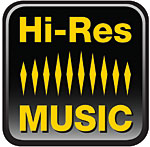 Most digital audio recordings are stored in a form called PCM, or pulse code modulation. You’ll often see hi-res music tracks described, for example, as “96/24 PCM” and packaged for download as either an uncompressed PCM file type such as WAV or AIFF or as a lossless compressed file type such as FLAC or ALAC. (See our Hi-Res Audio Glossary for an explanation of hi-res file types.)
Most digital audio recordings are stored in a form called PCM, or pulse code modulation. You’ll often see hi-res music tracks described, for example, as “96/24 PCM” and packaged for download as either an uncompressed PCM file type such as WAV or AIFF or as a lossless compressed file type such as FLAC or ALAC. (See our Hi-Res Audio Glossary for an explanation of hi-res file types.)
Another lossless, hi-res digital audio format called Direct Stream Digital, or DSD, captures only 1-bit samples, but at very high sampling rates, typically 2.8 or 5.6 million per second. You’ll often see these described, for example, as “DSD 2.8.”
Note that DSD is the same format as that used on SACD optical audio discs and qualifies those discs as HRA. Uncompressed hi-res music files, sometimes called LPCM, are often distributed on DVD and Blu-ray optical discs as well.
How does CTA define Hi-Res Audio?
To ensure consistency, Consumer Technology Association (CTA)®, Digital Entertainment Group (DEG), the Recording Academy Producers & Engineers Wing and various music labels have joined together to create a technical definition of Hi-Res Audio. According to CTA:
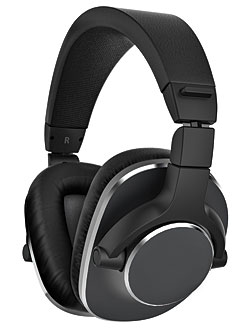 “High-Resolution Audio is lossless audio that is capable of reproducing the full range of sound from recordings that have been mastered from better than CD quality music sources.”
“High-Resolution Audio is lossless audio that is capable of reproducing the full range of sound from recordings that have been mastered from better than CD quality music sources.”
What equipment do you need to enjoy Hi-Res Audio?
Better audio playback gear will make the benefits of hi-res files more evident, though an expensive audiophile sound system is not required. Hi-res players, premium headphones, DACs and high-quality powered or passive speakers are among the products that support Hi-Res Audio. (See the HRA Gear Guide on page xx for a deeper look at hi-res product categories.)
Is hi-res playback supported for home, portable and car audio?
Yes to all three. A home hi-res library can be mated to a DAC and home audio system, and there are A/V receivers, integrated amplifiers and even wireless multi-room audio systems now with built-in DACs that handle hi-res files. Portable players are widely available at varying prices and can be plugged into today’s premium car audio systems for hi-res music on the road, though we’re starting to see the first hi-res-compatible in-dash players as well.
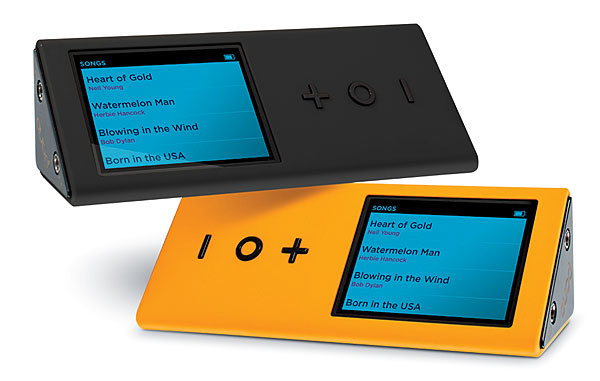
Where can listeners acquire hi-res music?
Several online music stores specialize in offering a variety of hi-res music today, and more seem to be launching all the time. Chief among them are HDtracks.com, SuperHiRez.com, iTrax, Onkyo and Neil Young’s Pono.com music store. There are also many specialty and independent audiophile recording labels who offer their own libraries for sale. Beyond this, many of the major and smaller music labels provide hi-res music on disc-based media such as SACD, Blu-ray and DVD.
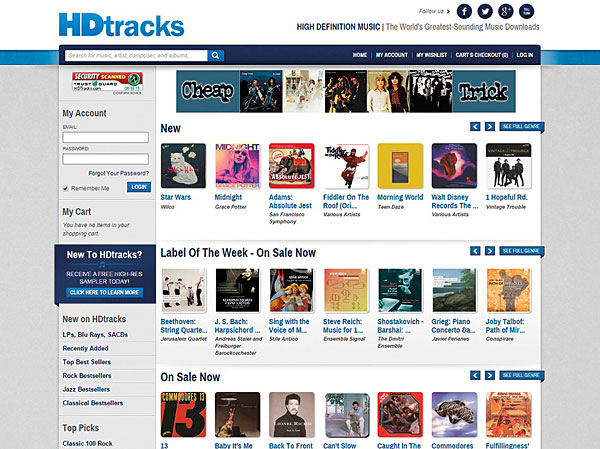
Are there streaming music options for hi-res listening?
The higher bandwidth requirements of Hi-Res Audio, coupled with low consumer awareness, to date have kept the most popular online music services from offering hi-res streams. It is expected that more services will get on board as lossless compression technology improves, bandwidth becomes cheaper and consumer demand for Hi-Res Audio grows. However, one music streaming subscription service, Tidal, has already announced plans to launch a hi-res tier.
What kind of music content is available in hi-res?
Whatever kind of music you love, you’re likely to find a good representation at the largest hi-res music stores. The major record labels have caught on to the opportunity represented by Hi-Res Audio and moved aggressively to remaster and rerelease many classic back-catalog titles through these retail channels. Simultaneously, many of today’s artists are making new music available in Hi-Res Audio formats as well.
- Log in or register to post comments


Yes, but that is cheap. I have two 3TB drives (one is physical backup). They're under $150 these days.

Yes hard drives are selling at bargain basement prices these days. The issue for me is I would need an entire forest of them to equal several thousand CD's worth of downloads. These files are BIG!

...and availability, for that matter.
If you're going to have nothing but disk-hungry, DSD 128 files, then you'll get only roughly 250 albums per 1 TB of disk space.
(See http://www.crutchfield.com/S-f83gBGf7jCd/learn/high-resolution-audio-gui...)
It's not like every digitized album is available in DSD 128.
I recently ripped 400+ CDs at 44.1/16 and it only cost me 138GB worth of space.

As noted above, you can fit about 250 high-res albums on 1TB...a 12TB WD My Book could hold almost 3000 high-res albums. Buy a 2nd one for backup purposes. True, that much storage is no longer cheap ($450x2).

Didn't realize hard drives had gotten that big. As you say not cheap but definitely doable if I'm going to go whole hog into this. Thanks.

They're not QUITE that big...the 12TB My Book uses (2) 6TB drives in RAID 0 or JBOD. You will need Windows 7 or more recent.

I'm a little surprised by the inference that a USB DAC is necessary. Most readers here will have a receiver with an HDMI input capable of handling multi channel high res audio.

...the server and the renderer - BOTH have to support the resolution that's been encoded and decoded. Some DLNA server solutions re-sample the files to 44.1 or 48 kHz, and some renderers can only receive up to a certain frequency via DLNA. Check your manuals FIRST, to (re)set your expectations.

Yes, my receiver can only handle high-res stereo tracks and not 5.1. However, my Oppo BD player can accept high-res 5.1 DLNA stream from Foobar2000 and transmit over HDMI to receiver. Or I can plug in laptop directly to receiver over HDMI with Foobar2000.

...you're an Apple fanboy who wants to overcome the 96/24 stock soundcard limit.

..."The Apple Fanboy's Guide to Downloadable Hi-Res Audio (and how to overcome the limitations of the Apple ecosystem)."
My goodness - outside of the FAQ's and Glossary, I don't think SACD was mentioned anywhere else... There sure were quite a number of iTunes mentions, though!

Quote "Hi-Res Audio tracks capture the details, instrument and vocal timber and textures" The only wood I want to hear is that of the speakers, I would much rather hear the timbre of the voices.
There is no mention of the provenance of the recordings, if I re record a cassette tape to 192/24 does it then become a Hi Res Music file?
The whole chain from artist's performance right through to the end product should be Hi Res, not just the final container file

there's been some advancement here on information of provenance, but a lot of it is private or lost.
in the hands of mastering 'masters', anything they are given can be taken up to 24/192 and be worthy of a listen. so yes, your statement is correct. it's the new hi-res master if they bothered.
if it's just up sampled it's a scam. no one is advocating that or selling it. when it sneaks through it's pulled and treated as a mistake. pono even offers a lifetime res upgrade.
most things aren't coming from cassette, of course. or 16/44, there's no point. if it's locked at 16/44 when recording it probably is, i don't think any label is in a hurry to get it to 24bit.
it's the old tapes and the new releases that are key here. the old tapes can be digitized again at 24/192, and then sold to consumers finally. the new sessions can be distributed that way, effectively giving the mp3 people their 10% version but still having an outlet for selling the full version.

Hi-res is all well and good, but I have not yet heard a major difference that would result in people like me - you know, regular people who have to worry about oh, you know, paying rent and utilities and buying food and shelter - spending a fortune to replace all the CDs we have with downloaded hi-res versions that usually cost between $25-$30 a pop. Hey, I can find great Blu-ray discs on the "A" site and other online retailers for less than $10, but if I had to pay 3 times that to download a hi-res version of the movie, I would tell them to go scratch. Why should hi-res audio be any different.

I'll admit...I have a high frequency hearing cutoff at around 4KHz (both ears), but I still enjoy my music and can have meaningful conversations. I'll also admit purchasing a Sony HAP-S1, HRA player that I like, very much.
Unfortunately, I disagree with most of the hype about HRA. Of the "scientific" studies I've read, all indicate that the (average) human ear simply cannot discern a difference between CD quality audio and HRA. The arguments against HRA are impressive, from the inability of the human ear to hear frequencies in excess of 20KHz, to the problem with the ability to listen (without extreme pain) to audio levels that span a 24dB range (or greater).
This HRA guide reproduces (again) an audio "waveform" that has been shown to be totally inaccurate, in the attempt to relate to the listener the difference between analog and digital audio. I don't know why this information continues to be reproduced, other than to convince non-technical types of the dubious differences between the two mediums. If it weren't for the fact that I work in the field of electronics and have kept abreast of the technological changes, since the tape and vinyl era, I, too, might have been sucked in by this "sleight of hand".
On a similar note...while I might discern the difference between a long run of 28 gauge speaker wire, versus 14 gauge and likely notice a difference of 64Kbps sampled audio, versus 44.1Kbps, you cannot convince me that I will hear the difference between plain copper and solid gold wires of the same gauge. You also would be hard pressed to convince me of the audio improvements between 44.1K and 96K sampled recordings. The differences are just too slight.
I do agree that CD quality audio is WAY better than either vinyl or tape...Hell, I grew up in the 60's and 70's and have heard it all. I also agree that HDTV (on a larger screen) beats the crap out of old 420 line video. Those are major differences that are easily discerned by the human ears and eyes...even ones as old and decrepit as mine. What I have been entirely unable to realize, however, is a noticeable difference in HRA over my CD collection. It just ain't happenin' here.
My final comment is, if you are looking to move up to HRA equipment and files...get your hearing checked, first. If your hearing qualifies as average to lower than average...save your money, as you will be unlikely to appreciate what you will be spending your hard earned money on.
Oh...I mainly purchased the Sony to: a. Have a desktop player with all my music onboard and b. To prove or disprove the HRA hype. I'm good with a., but b. has totally failed to convince me.

The discussion of Radio Randy hit home with me. I love my music but suffer similar hearing difficulties (too much loud music in the 60's and 70's) I'll stick with my vinyl, CD's and occasional iTunes download. Thanks for the article.

First its our girlfriends and wife's convincing us not to buy any audio-video gear cause they can't tell the difference. Now we are going in to the doctor's office and asking his advice.? If you love music and your hearing is bad (get a hearing aid)! your bound to start hearing everything again.(which could save your life !) The problem is that most of us don't really listen. If the average person sat down with a blind person and they hear the same track.. that's because their auditory senses are developed. The other problem that many of us might be suffering from is called (auditory processing disorder)its a glitch in the brains ability to filter and process sounds. If you've never played an instrument and done any studio work you ear is not developed. Unless your gifted. But really the most important thing is that everybody listens to music, in what ever format. The more you listen the better you get at listening. Get in your favorite chair, close your eyes and try to pick out every instrument. you will start hearing things you didn't know was there. Listen to Hi-res,non Hi-res, different volumes, different amps,speakers ect. That's all part of loving the gift of MUSIC !

